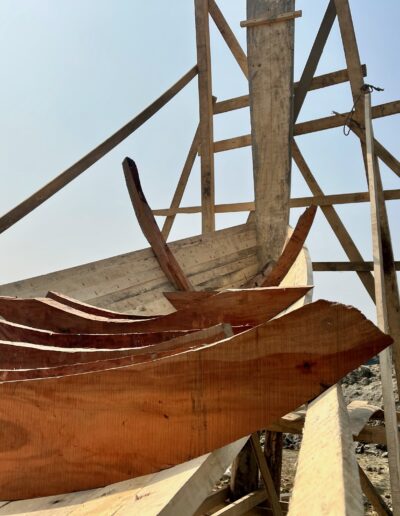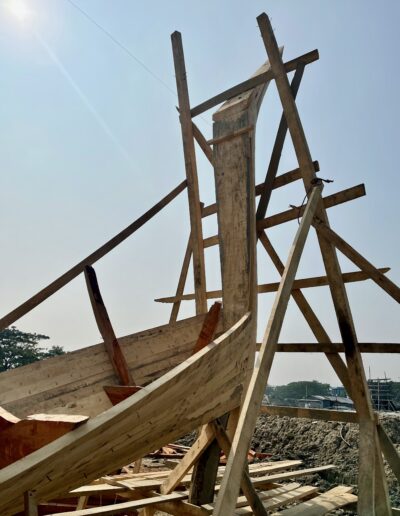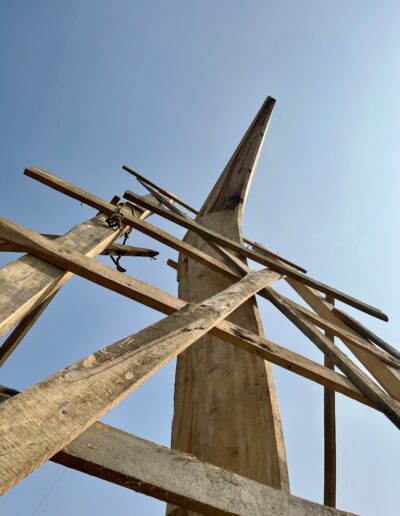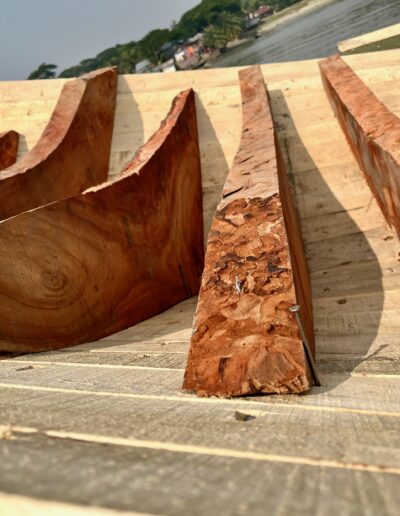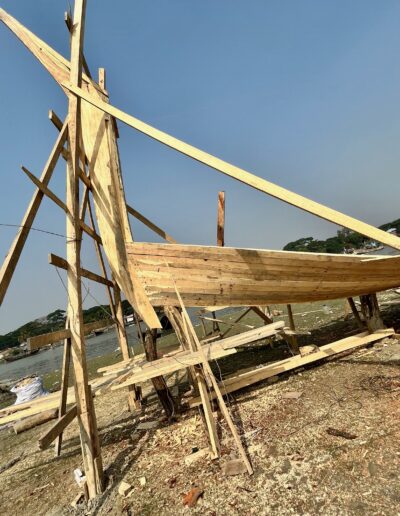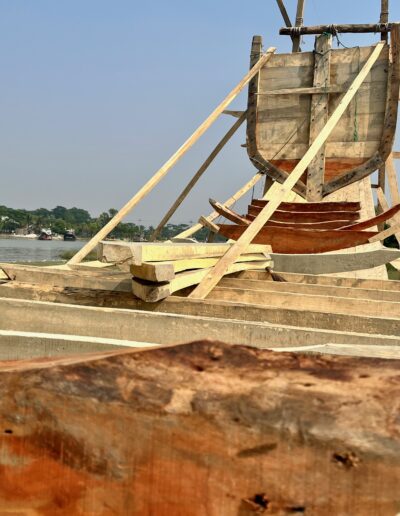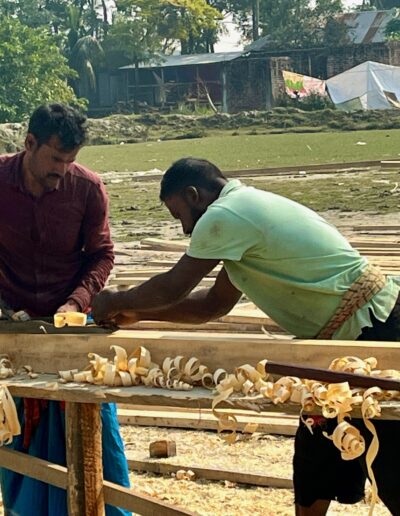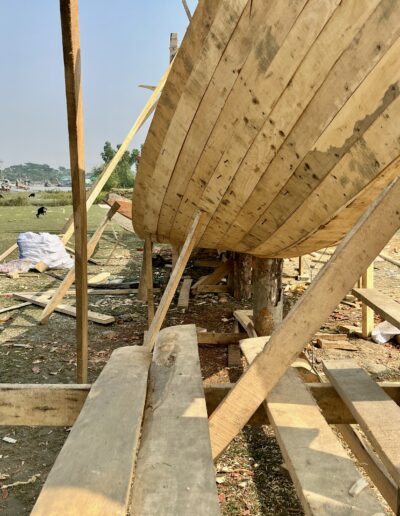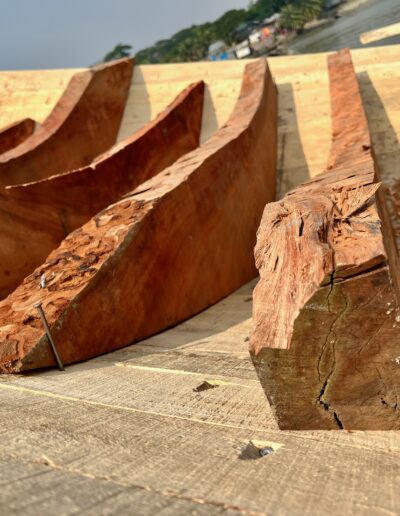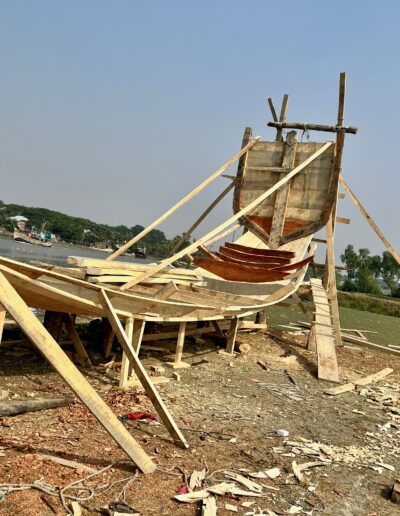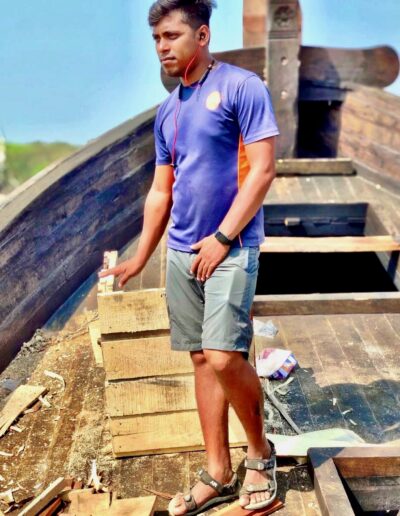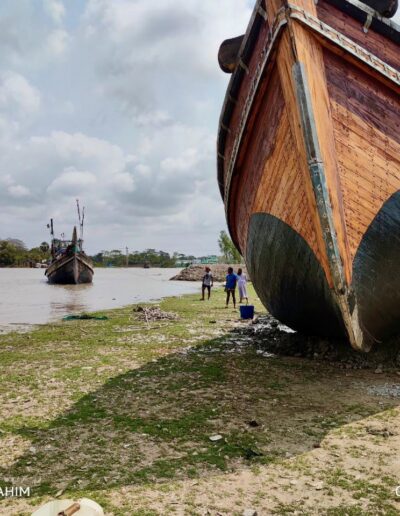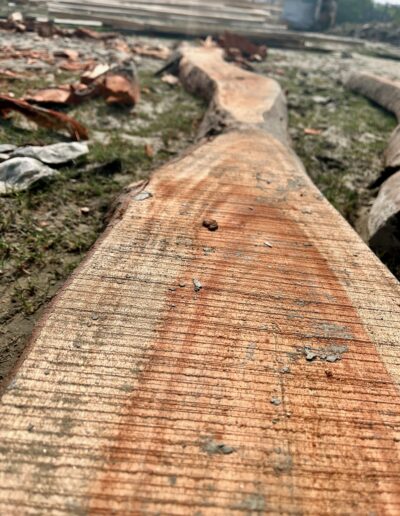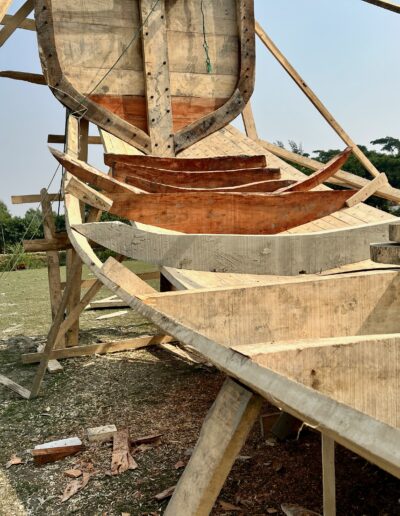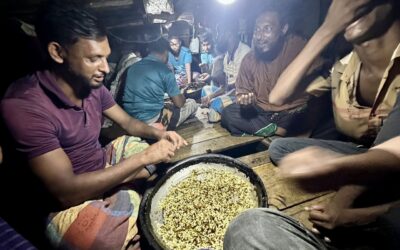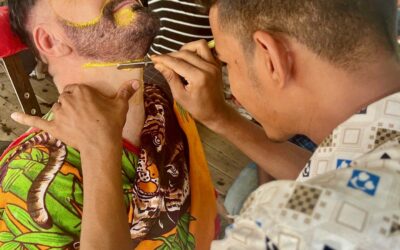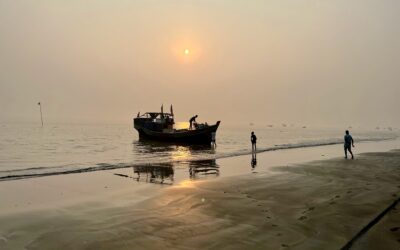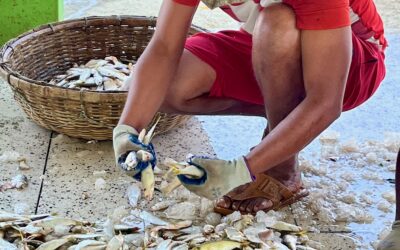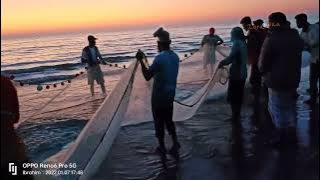Building Wooden Sampan Fishing Boats – Bangladesh
Discovering the Sampan: A Unique Maritime Craft
In the coastal regions of South and Southeast Asia, where the ocean is both a giver and taker of livelihoods, a remarkable wooden vessel quietly reigns supreme—the Sampan. With its distinct features and deep-rooted cultural significance, this traditional boat serves as a lifeline for many communities.
Let’s embark on a journey to explore the Sampan, tracing its design, construction, and the indomitable spirit of the fishermen who command them.
The Unique Anatomy of a Sampan
At first glance, Sampan’s design stands out. It is characterized by a fat bottom expertly crafted along an elegantly curved keel line. This distinctive shape is crowned with an “anni”—a sharply rising head that commands attention from afar. These elements aren’t just for show; they play crucial roles in the vessel’s stability and navigability, particularly in the challenging conditions of the Bay of Bengal.
The Sampan’s construction is a testament to artisanal skill. It involves various types of wood, including Pitraj, Gamari, Jam, Garjan, Phool Karai, and Hinyari. Each piece is meticulously shaped and fitted using hand tools under the sun’s relentless heat.
It’s a craftsmanship that blends tradition with utility, ensuring each vessel is a work of art and a functional survival tool.
Life Aboard the Sampan
Once the hull is completed and sealed with tar, and the diesel engine roars to life, the Sampan becomes a microcosm of life at sea. Every inch of the boat is utilized strategically: beneath the deck lies a storage area packed with ice and freshly caught fish, while the crew’s living quarters are set above. The top deck features a squat toilet, a small luxury amidst the constraints of space, and a dedicated cook ensures that the essentials of life—a hot meal—are never more than a few steps away.
Each voyage sees up to 20 men navigating the vastness of the sea, confronting the whims of weather for days on end.
Their resilience is astounding as they endure extreme conditions to earn a living, their fate interwoven with the Sampan’s wooden hull.

The Lifecycle and Cultural Significance
Despite the durable tar coating, the Sampans’ lifespan rarely exceeds five years before the wear and tear of the sea take their toll and the hulls begin to rot. This fate sees these once-majestic vessels repurposed as firewood—a somewhat ironic twist given the toxic nature of their protective layers.
Clusters of Sampans dot the shoreline, a testament to their pivotal role in regional economies and cultures. Watching these boats return loaded with the day’s catch or heading out for new adventures is a spectacle of skill and tradition.
The etymology of the word “Sampan,” originating from the Cantonese phrase for “three planks,” underscores the vessel’s global footprint. While the Chinese Sampan features a hull from a single plank flanked by two side planks, the Chittagonian Sampan showcases a unique variation with narrow wooden straps.
Despite these differences, similarities in design, such as the hull shape and thatched shelters, reveal an intriguing cross-cultural dialogue in maritime architecture.
The Global Footprint of Sampans
Sampans are more than just boats; they are cultural emissaries, embodying the heritage and ingenuity of coastal populations across Bangladesh, Myanmar, Malaysia, Indonesia, Vietnam, China, and Japan. Each region has bestowed its identity onto these vessels, whether through the Chittagonian Sampan’s rising head and triangular sail or the universal utility of its structure.
In exploring the Sampan, we unearth not just a mode of transport but a vibrant tapestry of human adaptation and cultural expression.
Each plank and screw tells a story of endurance, community, and the timeless dance between humanity and the sea. As we delve deeper into the lives they support, we’re reminded of the incredible diversity and ingenuity that characterizes our world—a reminder that even the humblest of crafts can encapsulate the spirit of a people.
Greetings! Welcome back, Newbie & Master Creatives.
This is The Creative Path, a freelance, subscriber-supported publication focused on helping you develop content-creation skills so you can live, love, and learn on your terms.
My job is to give you fresh insights as you launch your creative content ideas joyfully.
In Bangladesh, where rivers meet the sea,
The Sampan sails with quiet dignity.
A wooden craft, both humble and grand,
Born of skill from a craftsman’s hand.
Its belly broad, its head held high,
A crescent curve against the sky.
Crafted from woods like Garjan and Jam,
Each plank whispers tales of where it began.
Upon its deck, life sways and breathes,
Amidst the dance of the ocean’s heaves.
Twenty souls in unity bound,
In hope and courage, futures found.
With each voyage, the Sampan sings,
Of fishermen facing nature’s swings.
Braving storms with grit and grace,
Their lives defined by water’s embrace.
Though Sampans may only last a tide,
Their legacy in hearts abides.
A tapestry of culture and art,
In every curve, a story impart.
When wood meets flame in final rest,
The cycle of life’s journey manifest.
In coastal whispers, the Sampan’s lore,
Echoes forever on a distant shore.
From the Bay of Bengal to global seas,
The Sampan sails on gentle breeze.
Bridging worlds with its wooden form,
A symbol of humanity weathering the storm.
In each plank, a dream takes flight,
Underneath the stars of a tropical night.
A vessel of hope, resilience, and pride,
On the endless journey of the ebbing tide.
Daniel~Ibrahim
Ibrahim’s employer owns three of these impressive fishing boats.
Unfortunately, these boats rarely last five years before their hulls start rotting out despite the tar-based bottom coat. Discarded boats are chopped up and used for firewood, which I find odd, given the toxic burnoff of their protective coatings.
Clusters of sampan boats docked up and down the shoreline, with many waiting to head out or returning from 3-10 days of fishing on the Bay of Bengali. It’s incredible to see how skilled those fishermen are, living and working on these boats in groups of as many as 20 men per vessel for days on end, extreme rain or shine, for a few dollars a day.
Let's KEEP in TOUCH
My job is to give you fresh insights as you joyfully launch your creative content ideas.
Follow
https://ibradan.com
https://www.facebook.com/ibradancreative
https://www.facebook.com/dan.trepanier
https://www.instagram.com/dantrepanier
https://www.youtube.com/@IbraDanCreative
https://medium.com/ibradan-creative
https://me.dm/@ibradancreative
https://www.linkedin.com/in/danieltrepanier
https://www.pinterest.ca/ibradancreative
https://ibradancreative.substack.com
There’s so much excellent raw content here!
In this video, there is one boat which, as a vlog, felt close to my heart. Amazingly, it was built in 30 days. I was in Canada, and Ibrahim lived in Bangladesh when they started to build. He did some support work on the boat, applying the bottom coat and general labor.
Later that month, when I arrived, I started taking raw videos and images of the process, feeling deeply connected to every step. Perhaps it’s because I have a sailboat in Toronto, Canada, and am close to the water.
I love the way this project came together.


Looking ahead, I’m excited to use Final Cut Pro to weave together a comprehensive video with captivating drone shots that will bring the entire boat-building journey to life.
With their rich history and countless stories of the fishermen who rely on them, these boats hold a unique allure. I’m excited to share these stories with you, and I hope you’ll stay tuned for more updates!
#SampanStories, #WoodenCraft, #BangladeshBoats, #CulturalHeritage, #TraditionalFishing, #MaritimeCrafts, #OceanLife, #HandcraftedBoats, #CoastalCommunities, #BayOfBengal, #ArtisanalSkill, #FishingTraditions, #CulturalEmissaries, #GlobalFootprint, #ResilienceAtSea, #TapestryOfCulture, #HumanIngenuity, #MaritimeArchitecture, #SampanSailing, #CoastalJourneys,
SHOWCASE – Bangladesh Stories
B-Roll Bangladesh Fisherman -Dock Workers Enjoying Meal on a Wooden Sampan Boat
Ibrahim’s buddies working at the Alipur fish docks and market in Bangladesh were invited for a meal by the fishermen, whose wooden sampan boats they unload.
Ibrahim’s Video Creation – Parasailing Bangladesh
Experience the creative journey behind our videos. From editing on an iPhone to adding a signature outro bumper, explore the transformation of raw materials into captivating content like the thrill of parasailing in Cox Bazaar along the Bay of Bengali.
Unforgettable Motorcycle Rides Through Bangladesh
Tapping into your creative genius is a journey worth taking. With effort, patience, and practice, the rewards are great. Don’t be afraid to take the leap, take risks, and embrace your imperfections. Creativity is not just about producing something extraordinary; it’s...
Want to Experience Bangladesh Like a LOCAL on a RickShaw? Watch This Now
Take a Cycle Rickshaw! In this video, Ibrahim and I experienced exciting rickshaw rides throughout Bangladesh’s stunning landscapes. From bustling cities to serene countryside, this short video captures the beauty of travel in an exotic land. See how we experienced...
THRILLING Parasailing Adventure in Bangladesh!
Experience the creative journey behind our videos. From editing on an iPhone to adding a signature outro bumper, explore the transformation of raw materials into captivating content like the thrill of parasailing in Cox Bazaar along the Bay of Bengali.
I Found the BEST Haircut in Bangladesh and Here’s What Happened
My 30-day Experiment with Creative Freedom involved immersing myself in Bengali culture and toying with a new look. In this video, Ibrahim and I visit a local barber shop. It was about a different haircut and shave experience than I was traditionally used to, about...
What Happens When You Take a WILD Tuk Tuk Ride in Bangladesh?
I embarked on a creative journey with the more extended Rickshaw clip, transforming it into the captivating ’60-second Daily Joy Reel’.
Ibrahim raised the Bangladesh flag under a Canadian flag in a show of solidarity with the fight for democracy and justice
The civil unrest and violent clashes between civilians and a highly corrupt Bangladesh government are heartbreaking to watch—particularly for immigrants like Ibrahim, who have many family and friends back home impacted by this conflict.
Stunning Sunset Sunrise – Kuakata Sea Beach, Bangladesh
The sun rising and setting over the Bay of Bengal makes it a unique place in the region, providing a perfect view of beautiful nature. This video is a simple compilation of raw clips we took throughout visits in 2022-2023.
Working at the Alipur Fish Docks and Market – Bangladesh
Ibrahim and the salty, weathered Muslim men who work in his rural village of Alipur live a simple, harsh, yet spiritually connected life.
Bangladesh’s SHOCKINGLY Beautiful Fatrarban Mango Forest Is A MUST SEE!
It was a lovely experience to visit Ibrahim’s sister, her husband, and their children near the Tengragiri Eco Park Wildlife Sanctuary in Bangladesh (also known as the Mangrove Beauty—Sundarban/Fatrarban).
Bangladesh Fishermen Collecting Fish With Nets at Sunset
Sunset walks along the beach in Bangladesh, watching a group of fishermen pull in their nets, are followed by trips to the port, where a fantastic variety of fish come in every day.
WHY You Must Speak Truth to Power When Painfully Denied a Tourist Visa
Applying for a tourist visa (Temporary Resident Visa) to Canada should be simple, painless, and fair. But these days, it’s far from that.
WHAT IF You Had to Go to Bangladesh During a Pandemic, Shit Yourself Silly, and Eat Roadkill to Find Love. Would You do it?
I was forced to follow my gut, take my time, and make the best choice on the wildest romantic half-my-age encounter ever.


